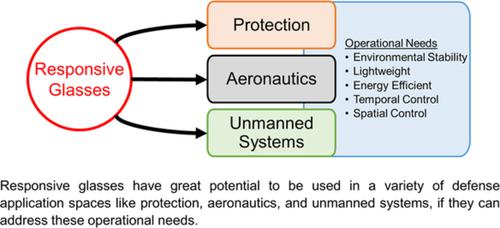当前位置:
X-MOL 学术
›
Polym. Int.
›
论文详情
Our official English website, www.x-mol.net, welcomes your
feedback! (Note: you will need to create a separate account there.)
Stimuli‐responsive mechanical properties in polymer glasses: challenges and opportunities for defense applications
Polymer International ( IF 2.9 ) Pub Date : 2020-11-13 , DOI: 10.1002/pi.6154 Joseph M Dennis 1 , Alice M Savage 1 , Randy A Mrozek 1 , Joseph L Lenhart 1
Polymer International ( IF 2.9 ) Pub Date : 2020-11-13 , DOI: 10.1002/pi.6154 Joseph M Dennis 1 , Alice M Savage 1 , Randy A Mrozek 1 , Joseph L Lenhart 1
Affiliation

|
The potential utility that responsive glasses provide in the areas of aeronautics, protection and unmanned systems is reviewed in this article. The article focuses on two broad classes of stimuli, photo and thermal, to better illustrate the challenges and convey some of the potential in developing these materials for the often extreme operational environments of defense applications. Three response mechanisms are outlined to provide a range of mechanical behaviors on demand: (i) shape‐changing functionalities which locally yield or soften the material to stimulate chain mobility; (ii) bond forming (or breaking) chemistries which increase (or decrease) the stiffness of the material; and (iii) energy absorbing groups which convert the incoming stimuli into a spatially controlled heating and result in a designed softening of the material. Overall, continuing to develop responsive polymer glasses that respond rapidly and efficiently under low energy inputs will be critical for future defense applications. Published 2020. This article is a U.S. Government work and is in the public domain in the USA
中文翻译:

聚合物玻璃的刺激响应机械性能:国防应用的挑战和机遇
本文回顾了响应式眼镜在航空,防护和无人系统领域提供的潜在用途。本文将重点放在两大类刺激上,即光刺激和热刺激,以更好地说明挑战并传达在国防应用中通常用于极端操作环境下开发这些材料的一些潜力。概述了三种响应机制,以提供按需提供的一系列机械行为:(i)形状改变功能,可局部屈服或软化材料以刺激链运动;(ii)增加(或降低)材料刚度的化学键形成(或破坏)化学作用;(iii)能量吸收基团,其将进入的刺激转换为空间控制的加热并导致材料的设计软化。全面的,持续开发在低能量输入下快速有效响应的响应式聚合物玻璃对于未来的国防应用至关重要。出版于2020年。本文是美国政府的工作,在美国属于公共领域
更新日期:2020-11-13
中文翻译:

聚合物玻璃的刺激响应机械性能:国防应用的挑战和机遇
本文回顾了响应式眼镜在航空,防护和无人系统领域提供的潜在用途。本文将重点放在两大类刺激上,即光刺激和热刺激,以更好地说明挑战并传达在国防应用中通常用于极端操作环境下开发这些材料的一些潜力。概述了三种响应机制,以提供按需提供的一系列机械行为:(i)形状改变功能,可局部屈服或软化材料以刺激链运动;(ii)增加(或降低)材料刚度的化学键形成(或破坏)化学作用;(iii)能量吸收基团,其将进入的刺激转换为空间控制的加热并导致材料的设计软化。全面的,持续开发在低能量输入下快速有效响应的响应式聚合物玻璃对于未来的国防应用至关重要。出版于2020年。本文是美国政府的工作,在美国属于公共领域









































 京公网安备 11010802027423号
京公网安备 11010802027423号